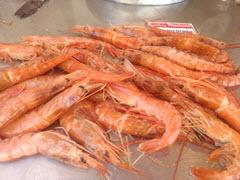 "Shrimp boats is a comin', their sails are in sight", but not within a thousand miles of Boston.
"Shrimp boats is a comin', their sails are in sight", but not within a thousand miles of Boston.
Big Shrimp
When you say shrimp will be served at an event, most people think first of the large shrimp served whole as a shrimp cocktail or on a salad plate. These shrimp are caught (and usually farmed) in the Gulf of Mexico, Thailand, China, the Phillipines, and Central America. They are almost invariably shipped frozen and then sold frozen, thawed, or thawed and cooked.
In my experience, it is always best to buy them frozen, thaw them slowly at home, and then cook them in small batches until they are all finished. This way you are most sure of consistent excellent results without undercooking or overcooking any.
For events, I always buy the Contessa brand 21-25/lb two-pound bag frozen. I thaw them for two days in the refrigerator, then I cook them a dozen at a time in a big stockpot at a rolling boil. They take only a couple of minutes, and start to float when done. If you add too many cold shrimp to the pot, or if you use too little water, the water cools too much and takes too long to come back to the boil.
Little Shrimp
The only food shrimp local to New England are the little red Northern Shrimp, known to us as Maine Shrimp. These are caught fresh off the coast of Maine, NH, and Massachusetts, but by far mostly in Maine. These are sometimes available in grocery stores as cooked, shelled salad shrimp. You can get fresh raw shrimp from a few fish markets and roadside trucks along Rte 1 in Maine beyond Portland. Because they are so small, shelling them takes a long time.
One of my favorite dinners on the road was the Maine Shrimp Caesar Salad at Le Garage in Wiscasset, ME, before the restaurant came under new management.
Shrimp and Prawns
Shrimp nomenclature is inconsistent and confusing. Here's my best attempt at decoding it:
-
Shrimp and prawns are most commonly interchangeable terms for the same crustacean, with the former more common in the US and the latter in the UK.
-
Among biologists and aquaculturists, shrimp is used more to mean the marine creature and prawn for the freshwater creature, although this usage is not without exceptions.
-
In the US, the term prawn sometimes is used to mean especially large shrimp, often over an ounce apiece. Prawn is commonly used in Chinese restaurants to indicate very large shrimp.
-
In Italy, the words for shrimp (gamberi) include an indication of their size: gamberoni are very large, gamberi are common shrimp, and gamberetti are small. Gamberi also come in red, pink, and white varieties. In Italy, the term scampi refers to langoustines (aka Dublin Bay Prawns) large, delicately flavored shrimp with claws, more closely related to lobsters. In between gamberi and scampi are mazzancolle, a gray shrimp highly esteemed for its flavor. Confusingly, the autotranslate feature in my browser translates all of these as prawns.
On this site, I will strive to use only these terms:
- Maine Shrimp are the little, local ones that are too small to eat with your fingers.
- All other Shrimp are the bigger ones seen in recipes and even bigger ones in shrimp cocktail and on Super Bowl trays, etc. I normally use the 21-25/lb or 16/20 size unless stated otherwise in a recipe. Colossal shrimp are bigger still, they usually have a U-number that indicates how many of them make a pound.
- Italian recipes specify the Italian name in the original recipe, and the type of shrimp that I used when making it in Plymouth.
